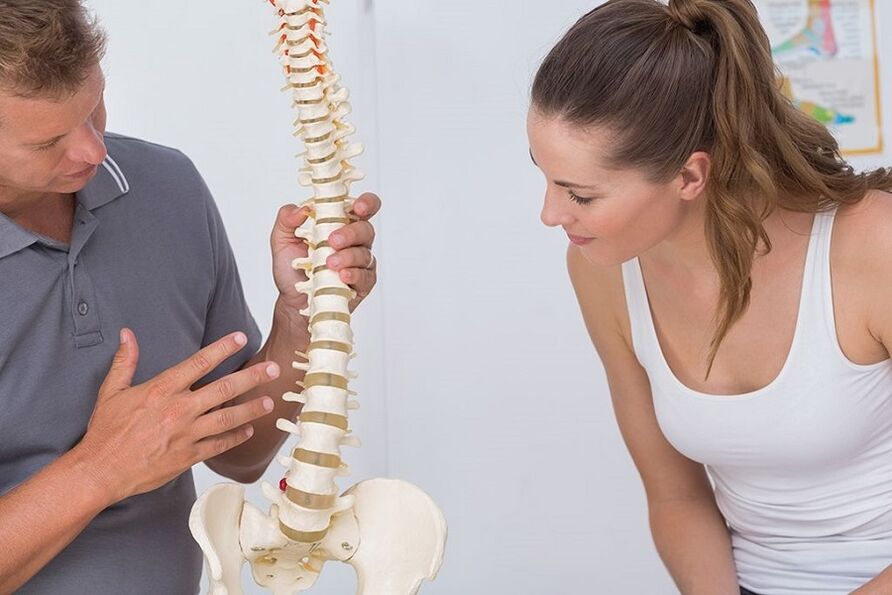According to medical statistics, cervical spondylosis is a fairly common disease in recent years. Every person at least once in his life experiences its unpleasant symptoms.

The disease itself is a malfunction of the discs of the cervical spine. After all, it is on this part of the human spine that the maximum continuous load occurs.
The cervical region consists of 7 discs. Due to his weak muscles and constant load, many injuries and interruptions in work are possible. Due to all these factors, cervical osteonecrosis begins to develop.
Types of diseases
Osteoma is a latent disease that may not manifest for a long time. There are several stages of the development of this disease:
- 1 degree cervical osteonecrosis (manifested by initial disorders of the spine);
- 2nd degree cervical spondylosis (the distance between the discs of the cervical spine begins to decrease);
- 3rd degree cervical spondylosis (complete destruction of the disc ring occurs and severe deformation of the entire spine begins);
- Grade 4 cervical osteonecrosis (late stage of disease progression, possibly leading to disability).
Causes of the onset and development of the disease
Like any other disease, cervical osteonecrosis has its own causes and developmental factors. Until a few decades ago, only the elderly were susceptible to this disease. In addition, osteonecrosis of the neck occurs in men after the age of 40 who do heavy work.
Nowadays, cervical osteosarcoma is increasingly common, affecting young people over the age of 20. There are many reasons that lead to the development of diseases of the cervical and thoracic spine:
- existing excess weight;
- poor posture and as a result a 1 or 2 degree curvature of the spine;
- hard physical labor or playing professional sports, due to various spinal injuries;
- reasons for severe stress and emotional stress;
- muscle weakness of the cervical region;
- stopping sports suddenly after prolonged exercise;
- work that involves sitting in front of a computer or in one position for long periods of time.
If you find yourself with the reasons listed, then you are in the so-called risky group. In this case, it is necessary to prevent cervical spondylosis.

Manifestations of the disease
With grade 1 osteonecrosis, a person does not feel practically any symptoms of the developing disease. Only the initial pinching of the neck muscles begins.
Grade 2 cervical osteosarcoma usually presents with mild pain that may occur in the neck and thorax. This occurs due to the compression of the nerve endings due to a decrease in the distance between the discs of the spine.
Grades 3 and 4 of the disease cannot go unnoticed. In this case, the deformation of the spine is noticeable to the naked eye, not to mention the sensations that a person experiences.
The main and more common symptoms of this disease include:
- severe persistent headache;
- bells in the head;
- impaired movement and coordination;
- impaired vision and oral health;
- cerebrovascular accident, insomnia and various neurological problems.
In grade 1, 2, 3 or 4 of the disease, the pain may radiate down into the shoulder and arm joints. One feature of this symptom, which distinguishes it from other diseases, is that the discomfort varies in intensity and concentration depending on the position of the neck and the rotation of the head.
Illness syndrome
All of the symptoms present in osteonecrosis can be proven inaccurate and as a result may be misdiagnosed. That is why, given the existing symptoms, it is necessary to find out all the reasons for their appearance. Thus, medical science knows several syndromes that distinguish between their originating causes:
Lens syndrome
In this case, the nerves are compressed and the person feels pain and numbness in part of the neck. The discomfort may spread to the back, to the scaly area, as well as the arms;
Stimulus reflex syndrome
Manifested by severe, unbearable pain in the back of the head, spreading all over the neck. Usually it occurs with a sharp movement or turning of the head;
Vertebral artery syndrome
In this case, the name speaks for itself. The artery is pinched and the person feels a severe headache, possibly losing consciousness or vomiting;
Heart syndrome
Manifested by increased heart rate, dizziness and loss of consciousness. Usually, in this case, a misdiagnosis is made and treatment for angina is initiated.

The treatment
With osteonecrosis, a person is always indicated for immediate treatment. His tactics are chosen depending on the extent of the disease. So at 1 or 2 degrees, full recovery is possible after treatment. In the later stages, medical correction is often aimed at preventing complications as well as improving quality of life.
First aid
What to do at the first symptoms of the disease? First, you need to relieve cervical pain. To do this, you need to take regular painkillers, lie down, or just relax.
The next step is to see a doctor for an accurate diagnosis and appropriate treatment.
Conservative treatment
With confirmed osteonecrosis, conservative treatment is usually indicated. Patients are prescribed anti-inflammatory drugs, pain relievers. Different gels or ointments can be used to reduce swelling and inflammation. In addition, the doctor can prescribe a course of massage, therapeutic exercises. Physical therapy for cervical spondylosis is indicated in most cases.
Surgery
In rare cases, with severe advanced osteonecrosis, surgery can be performed. In this case, the patient is put to sleep with the help of general anesthesia, after which the removal of bone formations between the intervertebral discs of the cervical spine is carried out. After manipulation, the patient received additional conservative treatment or physiotherapy.
Precautions
As the age of onset of tarsal osteonecrosis decreases, each person needs to take preventive measures. This is especially true for people at risk.
Important Rules
Prevention of cervical osteochondrosis includes the following simple but very important rules:
- observe your posture, do not allow it to bend;
- do not let the spine bear heavy loads;
- you cannot make sudden head movements;
- do not worry, avoid stress;
- no cold, no excessive cooling;
- Get rid of bad habits, switch to a reasonable diet.
Special exercises
To protect yourself from such a disease, you need to perform preventive exercises:
- put your palms on your forehead, squeeze your neck muscles, then put your hands behind your head and repeat the exercise, you need to do it for 7 seconds in 3 sets;
- put the palms on the temples, then also squeeze the muscles of the neck, repeat the same movement, otherwise, the time, number of approaches are the same as in the first paragraph;
- tilt your head back, then slowly bring your chin to the chest area, do the movement 3 times;
- turn your head in different directions - you need to do this exercise slowly, without sudden movements;
- Tilt your head back, first touch one shoulder with your ear, then touch the other, repeat the exercise 5 times.
If one or more symptoms of the disease occur, contact your doctor immediately. Perhaps you will only be prescribed physical therapy and this will be the end. Don't procrastinate, don't get sick.
Your daily exercise. Better to do elementary homework than to get sick later.
Ask your doctor how to sleep for cervical spondylosis. Follow all the rules, be healthy!

















































